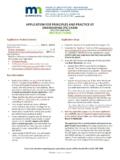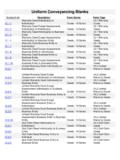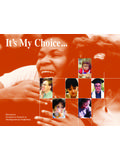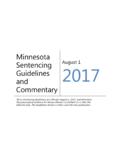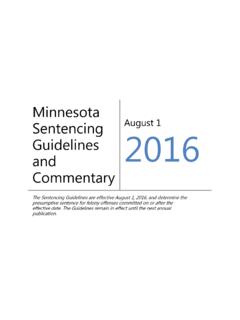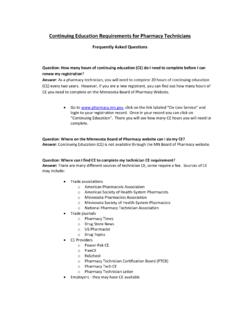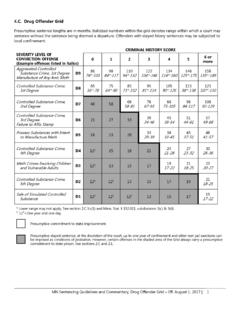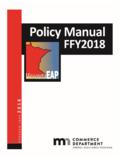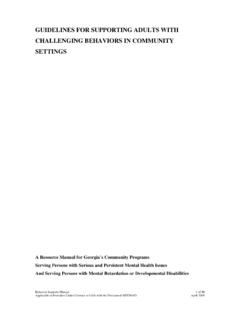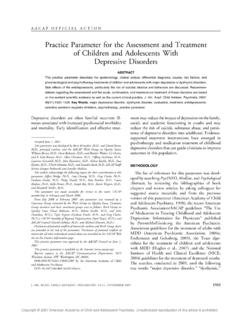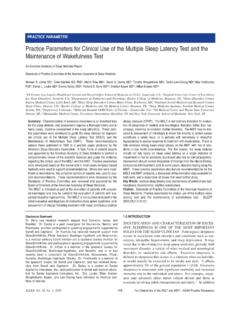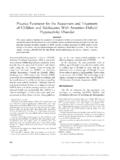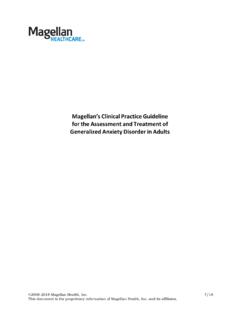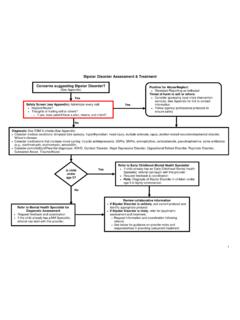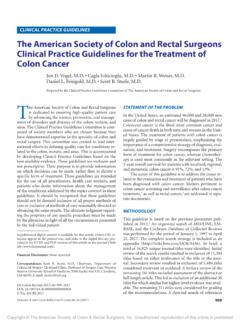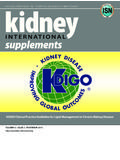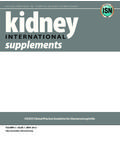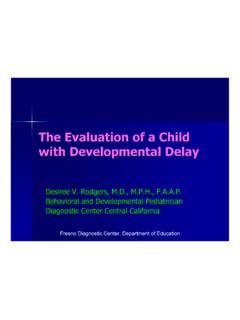Transcription of Eating Disorder Assessment and Treatment Protocol
1 Eating Disorder Assessment & Treatment 1 Concerns suggesting Eating Disorder ? (See Appendix) Clarify concerns with Eating patterns: Ask about dieting history, weight, restrictive and binge Eating , exercise patterns, purging, attitudes about weight, family history of Eating problems, family attitudes about Eating , and stressor. For parent: Do you have any concerns about your child s diet or behaviors related to Eating ? Consider using a screening instrument Safety Screen (see Appendix): Administer every visit Neglect/ Abuse?
2 Thoughts of hurting self or others? o If yes, does patient have a plan, means, and intent? Assess Medical Status and Comorbidity/Differential Diagnosis Assess medical status: <75% ideal weight, refusal to eat, heart rate near 40 bpm, systolic pressure 90 mm Hg, orthostatic changes in pulse or blood pressure, body temp below 96 F, arrhythmia, syncope, electrolyte imbalance, esophageal tears, intractable vomiting, low phosphate and refeeding syndrome Consider medical conditions: malignancy, gastrointestinal problems (Crohn s, celiac, infection), hyperthyroidism, diabetes, central nervous system disorders , superior mesenteric artery syndrome Consider comorbidity/differential diagnosis: OCD, Substance Use Disorder , Depression, chronic sexual abuse Positive for Abuse/Neglect: Mandated Reporting as indicated Threat of harm to self or others: Consider accessing local crisis intervention services.
3 See Appendix for link to contact information. Follow agency/professional protocols to ensure safety Refer for Eating Disorder Assessment Best option: Refer to Eating Disorder Clinic o Complete release of information and collaborate with provider. Alternative: If no Eating Disorder Clinic is available, complete releases of information and refer for specialized assessments by the following providers: o Dietician/Nutritionist, Mental Health Eating Disorder Specialist, Dentist o Gather information from family/caregiver. o Continue follow-up during Assessment process.
4 Review Assessment results and see below for Eating Disorder Treatment guidelines, if applicable. Yes No Yes Concerns/Positive screen Is immediate hospitalization indicated? Pursue hospital placement Identify hospital with Eating Disorder experience or ties to Eating Disorder program (See Appendix for provider list). Eating Disorder Assessment & Treatment 2 Eating Disorder Treatment Guideline Best option: An integrated ED Treatment program (See Appendix for listing of providers) Treatment requires a team approach that minimally includes the following specialists.
5 Ongoing communication between primary care and ED Treatment team is imperative. Note: Research on medication use for children and adolescents with Eating disorders is limited. Fluoxetine has been shown to reduce binge-purge behaviors in bulimia, but has only been proven for adults. Primary Care Provider Caregiver/Family Dietician/Nutritionist with Mental Health Specialist with Eating Eating Disorder expertise Disorder expertise Monitor medical status and progress Monitor symptoms, Eating toward developmental goals patterns, and behaviors to report Nutrition Assessment and P sychoeducation: refers to the o Assess medical status.
6 <75% ideal to providers education education offered to individuals with weight, refusal to eat, heart rate near Participate in Treatment as Provide nutrition targets, a mental health condition and their 40 bpm, systolic pressure 90 mm Hg, indicated recommendations, and families to help inform and empower orthostatic changes in pulse or blood Request feedback and pacing in order to optimize functioning pressure, body temp below 96 F, communication Monitor symptoms, patterns, P sychotherapy: a general term for arrhythmia, syncope, electrolyte Follow-up every 4-26 weeks behaviors, and progress treating mental health problems by imbalance, esophageal tears, depending on safety and medical talking with a mental health provider intractable vomiting, and low stability to learn about the condition, as well phosphate as moods, feelings, thoughts, and Assess for refeeding syndrome behaviors Continue inquiring about new/additional Consult with family/caregiver to concerns and safety track symptoms, Eating patterns.
7 Follow-up every 4-26 weeks depending and behaviors on safety and medical stability Inquire about new/additional Monitor for re-occurrence of symptoms concerns and safety Consult with family/caregiver to track symptoms, Eating patterns, and behaviors Pursue hospitalization or re-admission if indicated Eating Disorder Assessment & Treatment 3 Primary References: American Academy of Child and Adolescent Psychiatry Official Action (2015) Practice Parameter for the Assessment and Treatment of Children and Adolescents With Eating disorders .
8 American Academy of Child and Adolescent Psychiatry Official Action (2009) Practice Parameter on the Use of Psychotropic Medication in Children and Adolescents. (09)60156-8/pdf American Academy of Pediatrics (2010). Clinical Report Identification and management of Eating disorders in children and adolescents. Pediatrics, 111(1), 1240-1253. Academy of Eating disorders (2011) Eating disorders : Critical points for early recognition and medical risk management in the care of individuals with Eating disorders , 2nd Edition. Academy of Eating disorders , Deerfield, IL.
9 American Psychiatric Association (2013). Diagnostic and statistical manual of mental disorders (5th ed.). Washington, DC: Author. Couturier, J., & Lock, J. (2007). A review of medication use for children and adolescents with Eating disorders . Journal of the Canadian Academy of Child and Adolescent Psychiatry, 16(4), 173-176. PracticeWise (2015). Evidence-Based Youth Mental Health Services Literature Database. Pritts, , & Susman, (2003). Diagnosis of Eating disorders in Primary Care, American Family Physician, 67, 297-304. Williams, , Goodie, J.
10 , & Motsinger, (2008). Treating Eating disorders in Primary Care, American Family Physician, 77(2), 187-195. Appendix Potential Warning Signs of an Eating Disorder Need for Further Evaluation: Behaviors: excessive exercise, picky Eating , skipping or avoiding meals, eliminating food groups, suddenly complaining of feeling cold, deceptive Eating behaviors, excessive caffeine use, isolative or withdrawn behaviors, spending more time in room, going to bathroom following meals, changes in grades, comments on weight or collecting pictures of thin people Medical symptoms: marked weight gain, loss, or fluctuations.
